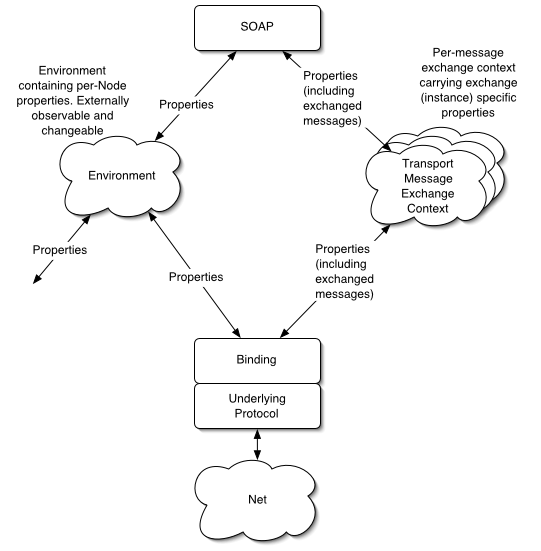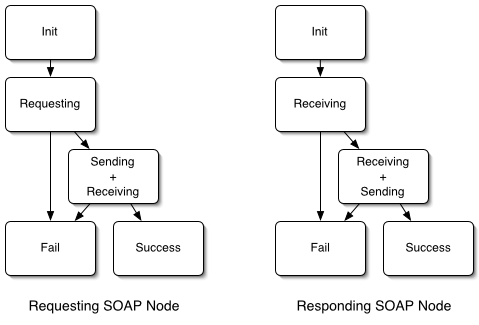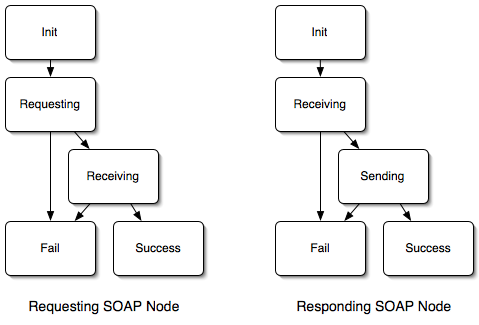C. Using W3C XML Schema with SOAP Encoding (Non-Normative)
As noted in 3.1.4 Computing the Type Name property SOAP graph nodes are
labeled with type names, but conforming processors are not required to perform
validation of encoded SOAP messages.
These sections
describe techniques that can be used when validation with W3C
XML schemas is desired for use by SOAP applications. Any errors
or faults resulting from such validation are beyond those
covered by the normative recommendation; from the perspective of
SOAP, such faults are considered to be application-level
failures.
C.1 Validating using the minimum schema
Although W3C XML schemas are conventionally exchanged in the
form of schema documents (see [XML Schema Part1]), the schema
recommendation is build on an abstract definition of schemas,
to which all processors need to conform. The schema
recommendation provides that all such schemas include
definitions for a core set of built in types, such as
integers, dates, and so on (see [XML Schema Part1],
Built-in Simple Type Definition).
Thus, it is possible to discuss validation of a SOAP
message against such a minimal schema, which is the one that
would result from providing no additional definitions or
declarations (i.e. no schema document) to a schema processor.
The minimal schema provides that any well formed XML document
will validate, except that where an xsi:type is provided, the
type named must be built in, and the corresponding element must be
valid per that type. Thus, validation of a SOAP 1.2 message using a
minimal schema approximates the behavior of the built-in types
of SOAP 1.1.
C.2 Validating using the SOAP Encoding schema
Validation against the minimal schema (see C.1 Validating using the minimum schema) will not succeed where encoded graph nodes
have multiple inbound edges. This is because
elements representing such graph nodes will carry id
attribute information items which are not legal
on elements of type "xs:string",
"xs:integer" etc. The SOAP Encoding of such graphs MAY be validated
against the SOAP Encoding schema.
In order for the encoding to validate, edge labels, and
hence the
[local name] and [namespace name] properties of the
element information items, need to match those
defined in the SOAP Encoding schema. Validation of the encoded
graph against the SOAP Encoding schema would result in the
type name property of the nodes in the graph being assigned
the relevant type name.
C.3 Validating using more specific schemas
It may be that schemas could be constructed to describe the encoding of
certain graphs. Validation of the encoded graph against such a schema would
result in the type name property of the graph nodes being assigned the
relevant type name. Such a schema can also supply default or fixed values
for one or more of the itemType , arraySize or
nodeClass attribute
information items; the values of such defaulted attributes affect the
deserialized graph in the same manner as if the attributes had been
explicitly supplied in the message. Errors or inconsistencies thus
introduced (e.g. if the value of the attribute is erroneous or inappropriate)
should be reported as application-level errors; faults from the
"http://www.w3.org/2002/12/soap-encoding"
namespace should be reported only if the normative parts of this
specification are violated.
D. Acknowledgements (Non-Normative)
This document is the work of the W3C XML Protocol Working Group.
Members of the Working Group are (at the time of writing, and by
alphabetical order): Vidur Apparao (Netscape),
Carine Bournez (W3C),
Michael Champion (Software AG),
Glen Daniels (Macromedia),
Paul Denning (Mitre),
Colleen Evans (Progress Software),
David Fallside (IBM),
Dietmar Gaertner (Software AG),
Martin Gudgin (Microsoft Corporation),
Marc Hadley (Sun Microsystems),
Gerd Hoelzing (SAP AG),
Oisin Hurley (IONA Technologies),
John Ibbotson (IBM),
Ryuji Inoue (Matsushita Electric),
Kazunori Iwasa (Fujitsu Limited),
Mario Jeckle (DaimlerChrysler R. & Tech),
Mark Jones (AT&T),
Anish Karmarkar (Oracle),
Jacek Kopecky (Systinet/Idoox),
Yves Lafon (W3C),
Michah Lerner (AT&T),
Amy Lewis (Tibco),
Noah Mendelsohn (IBM),
Jeff Mischkinsky (Oracle),
Nilo Mitra (Ericsson),
Jean-Jacques Moreau (Canon),
Don Mullen (Tibco),
Masahiko Narita (Fujitsu Limited),
Eric Newcomer (IONA Technologies),
Henrik Nielsen (Microsoft Corporation),
David Orchard (BEA Systems),
Andreas Riegg (DaimlerChrysler R. & Tech),
Herve Ruellan (Canon),
Marwan Sabbouh (Mitre),
Miroslav Simek (Systinet/Idoox),
Nick Smilonich (Unisys),
Lynne Thompson (Unisys),
Pete Wenzel (SeeBeyond),
Ray Whitmer (Netscape),
Volker Wiechers (SAP AG).
Previous members were: Yasser alSafadi (Philips Research),
Bill Anderson (Xerox),
Camilo Arbelaez (WebMethods),
Mark Baker (Idokorro Mobile (Planetfred)),
Mark Baker (Sun Microsystems),
Philippe Bedu (EDF (Electricite de France)),
Olivier Boudeville (EDF (Electricite de France)),
Don Box (DevelopMentor),
Tom Breuel (Xerox),
Dick Brooks (Group 8760),
Winston Bumpus (Novell),
David Burdett (Commerce One),
Charles Campbell (Informix Software),
Alex Ceponkus (Bowstreet),
Miles Chaston (Epicentric),
David Clay (Oracle),
David Cleary (Progress Software),
Conleth O'Connell (Vignette),
Ugo Corda (Xerox),
Paul Cotton (Microsoft Corporation),
Fransisco Cubera (IBM),
Ron Daniel (Interwoven),
Glen Daniels (Allaire),
Dug Davis (IBM),
Ray Denenberg (Library of Congress),
Frank DeRose (Tibco),
Mike Dierken (DataChannel),
Andrew Eisenberg (Progress Software),
Brian Eisenberg (DataChannel),
John Evdemon (XMLSolutions),
David Ezell (Hewlett Packard),
Eric Fedok (Active Data Exchange),
Chris Ferris (Sun Microsystems),
Daniela Florescu (Propel),
Dan Frantz (BEA Systems),
Michael Freeman (Engenia Software),
Scott Golubock (Epicentric),
Rich Greenfield (Library of Congress),
Martin Gudgin (DevelopMentor),
Hugo Haas (W3C),
Mark Hale (Interwoven),
Randy Hall (Intel),
Bjoern Heckel (Epicentric),
Erin Hoffman (Tradia),
Steve Hole (MessagingDirect Ltd.),
Mary Holstege (Calico Commerce),
Jim Hughes (Fujitsu Software Corporation),
Yin-Leng Husband (Compaq),
Yin-Leng Husband (Hewlett Packard),
Scott Isaacson (Novell),
Murali Janakiraman (Rogue Wave),
Eric Jenkins (Engenia Software),
Jim d'Augustine (eXcelon),
Jay Kasi (Commerce One),
Jeffrey Kay (Engenia Software),
Richard Koo (Vitria Technology Inc.),
Alan Kropp (Epicentric),
Julian Kumar (Epicentric),
Peter Lecuyer (Progress Software),
Tony Lee (Vitria Technology Inc.),
Bob Lojek (Intalio),
Henry Lowe (OMG),
Brad Lund (Intel),
Matthew MacKenzie (XMLGlobal Technologies),
Murray Maloney (Commerce One),
Richard Martin (Active Data Exchange),
Highland Mary Mountain (Intel),
Noah Mendelsohn (Lotus Development),
Alex Milowski (Lexica),
Kevin Mitchell (XMLSolutions),
Ed Mooney (Sun Microsystems),
Dean Moses (Epicentric),
Rekha Nagarajan (Calico Commerce),
Raj Nair (Cisco),
Mark Needleman (Data Research Associates),
Art Nevarez (Novell),
Mark Nottingham (Akamai Technologies),
David Orchard (Jamcracker),
Kevin Perkins (Compaq),
Jags Ramnaryan (BEA Systems),
Vilhelm Rosenqvist (NCR),
Waqar Sadiq (Vitria Technology Inc.),
Rich Salz (Zolera),
Krishna Sankar (Cisco),
George Scott (Tradia),
Shane Sesta (Active Data Exchange),
Lew Shannon (NCR),
John-Paul Sicotte (MessagingDirect Ltd.),
Simeon Simeonov (Allaire),
Simeon Simeonov (Macromedia),
Aaron Skonnard (Developmentor),
Soumitro Tagore (Informix Software),
James Tauber (Bowstreet),
Patrick Thompson (Rogue Wave),
Jim Trezzo (Oracle),
Asir Vedamuthu (WebMethods),
Randy Waldrop (WebMethods),
Fred Waskiewicz (OMG),
David Webber (XMLGlobal Technologies),
Stuart Williams (Hewlett Packard),
Yan Xu (DataChannel),
Amr Yassin (Philips Research),
Susan Yee (Active Data Exchange),
Jin Yu (Martsoft).
The people who have contributed to discussions on
xml-dist-app@w3.org
are also gratefully acknowledged.


